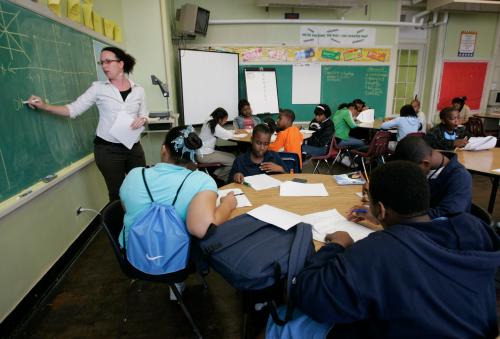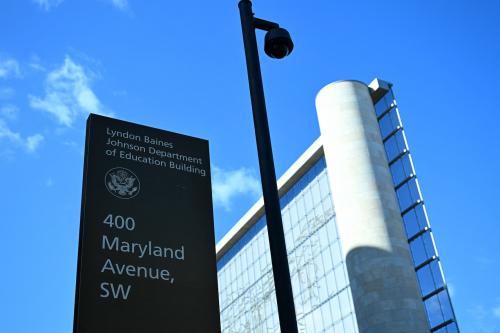Policy debates about the net effects of charter schools on students and on the delivery of K-12 education are ongoing and remain highly contentious. In a recent paper, we contribute to the policy discussion by drawing attention to the fiscal externalities of charter schools, a finance topic that deserves more attention in the overall discussion. Fiscal externalities are the additional burden that charter schools place on the budgets of traditional school districts, and we find evidence that they are consequential in North Carolina.
Although such burdens may manifest themselves in higher local tax burdens, the more likely outcome is reduced spending per pupil on educational services–and hence lower educational quality–for students who remain in the district’s traditional public schools. The presence of charter schools typically means that some of the funding that would otherwise have been available to the local school district is diverted to the charter schools. For example, assume that the funding arrangements are such that if 10 percent of a district’s students shift to a charter school, the district loses 10 percent of its revenue. The main problem is that the district cannot simply reduce its costs by 10 percent because some of its costs are fixed, especially in the short run. As a result, unless the district is able to offset the lost revenue with higher local tax revenue, it must cut its spending on variable inputs, such as teachers, by more than 10 percent.
Evidence from New York and North Carolina
In drawing attention to these fiscal externalities, we follow the lead of scholars Robert Bifulco and Randall Reback, who measured the adverse fiscal impacts of charter schools in two New York districts, Albany and Buffalo. They correctly point out that estimated magnitudes depend on state and local funding arrangements, and require explicit assumptions about how readily local districts can modify their spending patterns in response to revenue losses, as well about the proportion of charter students who otherwise would have attended private schools.
Our study goes beyond theirs in several ways, including applying the analysis to one medium-sized urban district and five non-urban districts in North Carolina. Attending to effects in these smaller districts is useful given the spread of charter schools beyond the large urban districts where charters have been most common.
In North Carolina, the state is the sole authorizer of charter schools and its authorizing legislation specifies that charter schools are to be funded at the same per-pupil rate as the public schools in the district where the students live. Funding for these purposes includes state funding which accounts for about 65 percent of statewide funding, and local supplemental funding which differs by district based largely on the wealth of the local county.
We collected financial data on school spending from six districts around the state to conduct the analysis. We selected Durham, N.C., (a county district with a traditional public school enrollment of 33,000 students) as our urban district because of: its relatively large share of charter school students (15 percent); its high local funding; and the explicit concerns of district policymakers that charters are adversely affecting the district’s ability to serve its students, many of whom are economically disadvantaged. We selected five illustrative non-urban districts based on their growing shares of charter school enrollments, and our success in obtaining the detailed local expenditure data needed for the analysis.
Measuring fiscal externalities
Estimating fiscal burdens is an art, not a science. Central to the analysis is categorizing local district expenditures into one of two categories. Variable costs–such as spending on teachers–represent those that can be cut back relatively easily with a change in the number of students. Conversely, fixed costs – such as those on administration and facilities–represent long-term funding commitments and are much harder to adjust in the short run.
For the simplest models, we assume that the district can reduce its variable spending on line with the loss of students and that fixed costs cannot be adjusted at all. In fact, however, the district will not be able to adjust its variable spending in this way if the students who shift to charter schools are spread across schools and grades. Hence, we also calculate short-run fiscal burdens that assume some stickiness in variable spending. For some of our estimates, we also vary the treatment of fixed costs by assuming that even in the relatively short run, the introduction of charter schools may allow a fast-growing district to slow its spending on facilities.
Despite these uncertainties and various modeling assumptions, the bottom line is clear. The growth of charter schools imposes clear fiscal pressures on local school districts in the short run. In Durham, for example, the burden is about $500 per traditional public school student. This estimate is somewhat smaller than the comparable per-pupil burdens of $900 and $700 Bifulco and Reback estimated in New York state using similar assumptions. Nonetheless, the potential adverse impact on education quality in Durham is likely to be larger because per-pupil spending in North Carolina is less than half that in New York.
The net fiscal burdens per traditional public school student for our five non-urban districts are lower than what we estimated in Durham, largely because of their lower charter school enrollment shares or reliance on local supplemental funding.
Changing the focus to the excess cost per student enrolled in a charter school, we calculate a burden of about $3,500 per charter school enrollee in Durham, and burdens of comparable or larger magnitudes in two of the non-urban districts.
Reducing fiscal burdens
These negative fiscal externalities suggest the desirability of statewide policies to ease the adverse fiscal impact of charter schools on traditional public schools. To the degree that such impacts of charter schools are temporary, one policy response would be for the state to provide transitional aid to smooth or mitigate revenue losses for school districts in proportion to the expansion of local charters. Such a program has precedents in New York and Massachusetts, although in neither case does the magnitude of the aid offset the full negative fiscal impacts of charters. Though charter school supporters may be likely to oppose such assistance, it is nonetheless difficult to argue against the logic that a state should bear the full costs of the charter schools it authorizes by including among those costs the negative externalities that new charter schools impose on the local districts.
Temporary assistance may not suffice, however, if some of the fiscal impacts are permanent. The state of North Carolina is constitutionally required to provide sufficient funding for all students in all local districts to receive a “sound, basic education.” While our estimates do not speak directly to the size of longer-run efficiency costs—even in a scenario in which charter school enrollments are no longer growing as a share of total local enrollments—the existence of two sectors implies duplication of functions and services (e.g., central office operations), hence raising per-student costs in traditional schools. Further, the presence of a charter sector in which schools may open or close for various reasons–such as financial mismanagement, academic failure, or changing parental preferences–generates uncertainty for district policymakers. This uncertainty makes it difficult for the district to plan and make efficient use of resources, requiring sufficient excess capacity to assure that all children will be served should charters shut down.
The short-run fiscal externalities documented here for North Carolina as well as the ongoing challenges of duplication and planning are likely to arise in all states. Their magnitudes and overall impacts on local education budgets and education quality are likely to differ across states depending on how well states fund charters relative to traditional public schools and how much of the funding comes from local revenue sources. We encourage charter school authorizers to examine the fiscal externalities imposed on traditional public schools in their areas to manage the growth of the charter sector more efficiently.
The Brookings Institution is committed to quality, independence, and impact.
We are supported by a diverse array of funders. In line with our values and policies, each Brookings publication represents the sole views of its author(s).







